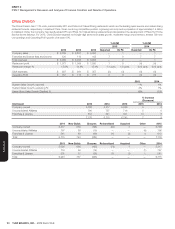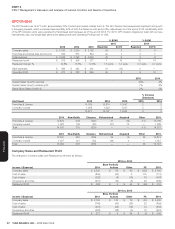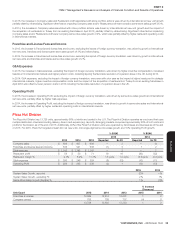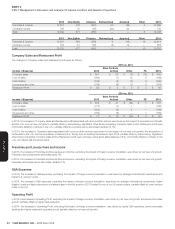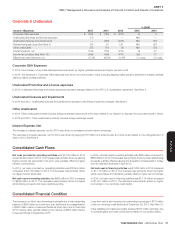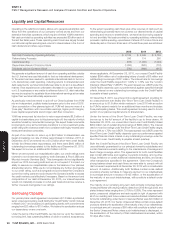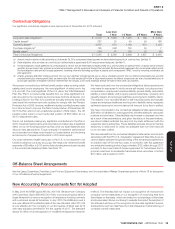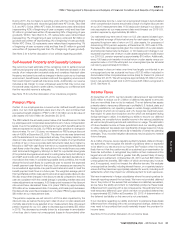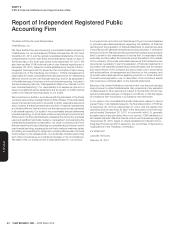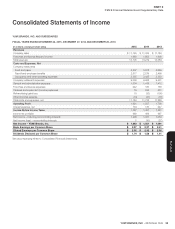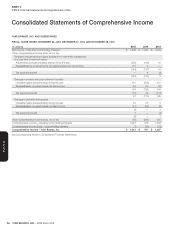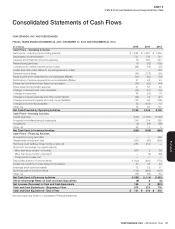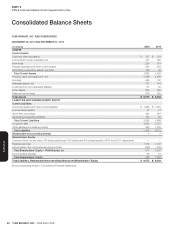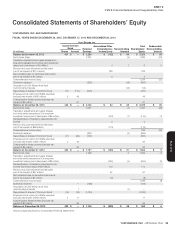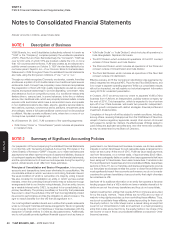Pizza Hut 2015 Annual Report Download - page 138
Download and view the complete annual report
Please find page 138 of the 2015 Pizza Hut annual report below. You can navigate through the pages in the report by either clicking on the pages listed below, or by using the keyword search tool below to find specific information within the annual report.
YUM! BRANDS, INC.-2015 Form10-K30
Form 10-K
PART II
ITEM7Management’s Discussion and Analysis of Financial Condition and Results of Operations
Critical Accounting Policies and Estimates
Our reported results are impacted by the application of certain accounting
policies that require us to make subjective or complex judgments. These
judgments involve estimations of the effect of matters that are inherently
uncertain and may significantly impact our quarterly or annual results of
operations or financial condition. Changes in the estimates and judgments
could significantly affect our results of operations, financial condition and
cash flows in future years. A description of what we consider to be our
most significant critical accounting policies follows.
Impairment or Disposal of Long-Lived Assets
We review long-lived assets of restaurants (primarily PP&E and allocated
intangible assets subject to amortization) semi-annually for impairment, or
whenever events or changes in circumstances indicate that the carrying
amount of a restaurant may not be recoverable. We evaluate recoverability
based on the restaurant’s forecasted undiscounted cash flows, which
incorporate our best estimate of sales growth and margin improvement based
upon our plans for the unit and actual results at comparable restaurants.
For restaurant assets that are deemed to not be recoverable, we write
down the impaired restaurant to its estimated fair value. Key assumptions
in the determination of fair value are the future after-tax cash flows of the
restaurant, which are reduced by future royalties a franchisee would pay,
and a discount rate. The after-tax cash flows incorporate reasonable sales
growth and margin improvement assumptions that would be used by a
franchisee in the determination of a purchase price for the restaurant.
Estimates of future cash flows are highly subjective judgments and can be
significantly impacted by changes in the business or economic conditions.
We perform an impairment evaluation at a restaurant group level if it is more
likely than not that we will refranchise restaurants as a group. Expected
net sales proceeds are generally based on actual bids from the buyer,
if available, or anticipated bids given the discounted projected after-tax
cash flows for the group of restaurants. Historically, these anticipated bids
have been reasonably accurate estimations of the proceeds ultimately
received. The after-tax cash flows used in determining the anticipated bids
incorporate reasonable assumptions we believe a franchisee would make
such as sales growth and margin improvement as well as expectations as
to the useful lives of the restaurant assets. These after-tax cash flows also
include a deduction for the anticipated, future royalties we would receive
under a franchise agreement with terms substantially at market entered
into simultaneously with the refranchising transaction.
The discount rate used in the fair value calculations is our estimate of the
required rate of return that a franchisee would expect to receive when
purchasing a similar restaurant or groups of restaurants and the related
long-lived assets. The discount rate incorporates rates of returns for
historical refranchising market transactions and is commensurate with the
risks and uncertainty inherent in the forecasted cash flows.
We evaluate indefinite-lived intangible assets for impairment on an annual
basis or more often if an event occurs or circumstances change that indicates
impairment might exist. We perform our annual test for impairment of our
indefinite-lived intangible assets at the beginning of our fourth quarter.
Fair value is an estimate of the price a willing buyer would pay for the
intangible asset and is generally estimated by discounting the expected
future after-tax cash flows associated with the intangible asset. Our most
significant indefinite-lived intangible asset is our Little Sheep trademark
with a book value of $56 million at December 26, 2015. The fair value
estimate of the Little Sheep trademark in our fourth quarter impairment
testing exceeded its carrying value. Fair value was determined using a relief-
from-royalty valuation approach that included estimated future revenues
as a significant input, and a discount rate of 13% as our estimate of the
required rate-of-return that a third-party buyer would expect to receive
when purchasing the Little Sheep trademark. The primary drivers of fair
value include franchise revenue growth and revenues from a wholly-owned
business that sells seasoning to retail customers. Franchise revenue growth
reflects annual same-store sales growth of 4% and approximately 35 new
franchise units per year, partially offset by the impact of approximately
25 franchise closures per year. The seasoning business is forecasted to
generate sales growth rates consistent with historical results.
Impairment of Goodwill
We evaluate goodwill for impairment on an annual basis as of the beginning
of our fourth quarter or more often if an event occurs or circumstances
change that indicates impairment might exist. Goodwill is evaluated for
impairment by determining whether the fair value of our reporting units
exceed their carrying values. Our reporting units are our business units
(which are aligned based on geography) in our KFC, Pizza Hut and Taco
Bell Divisions and individual brands in our China and India Divisions. Fair
value is the price a willing buyer would pay for the reporting unit, and is
generally estimated using discounted expected future after-tax cash flows
from Company-owned restaurant operations and franchise royalties.
Future cash flow estimates and the discount rate are the key assumptions
when estimating the fair value of a reporting unit. Future cash flows are
based on growth expectations relative to recent historical performance
and incorporate sales growth and margin improvement assumptions
that we believe a third-party buyer would assume when determining
a purchase price for the reporting unit. The sales growth and margin
improvement assumptions that factor into the discounted cash flows
are highly correlated as cash flow growth can be achieved through
various interrelated strategies such as product pricing and restaurant
productivity initiatives. The discount rate is our estimate of the required
rate of return that a third-party buyer would expect to receive when
purchasing a business from us that constitutes a reporting unit. We
believe the discount rate is commensurate with the risks and uncertainty
inherent in the forecasted cash flows.
The fair values of all our reporting units with goodwill balances were
substantially in excess of their respective carrying values as of the 2015
goodwill testing date.
When we refranchise restaurants, we include goodwill in the carrying
amount of the restaurants disposed of based on the relative fair values
of the portion of the reporting unit disposed of in the refranchising versus
the portion of the reporting unit that will be retained. The fair value of the
portion of the reporting unit disposed of in a refranchising is determined
by reference to the discounted value of the future cash flows expected
to be generated by the restaurant and retained by the franchisee, which
include a deduction for the anticipated, future royalties the franchisee will
pay us associated with the franchise agreement entered into simultaneously
with the refranchising transaction. Appropriate adjustments are made to
the fair value determinations if such franchise agreement is determined
to not be at prevailing market rates. When determining whether such
franchise agreement is at prevailing market rates our primary consideration
is consistency with the terms of our current franchise agreements both
within the country that the restaurants are being refranchised in and
around the world. The Company believes consistency in royalty rates
as a percentage of sales is appropriate as the Company and franchisee
share in the impact of near-term fluctuations in sales results with the
acknowledgment that over the long-term the royalty rate represents an
appropriate rate for both parties.
The discounted value of the future cash flows expected to be generated by
the restaurant and retained by the franchisee is reduced by future royalties
the franchisee will pay the Company. The Company thus considers the
fair value of future royalties to be received under the franchise agreement
as fair value retained in its determination of the goodwill to be written off
when refranchising. Others may consider the fair value of these future
royalties as fair value disposed of and thus would conclude that a larger
percentage of a reporting unit’s fair value is disposed of in a refranchising
transaction.


